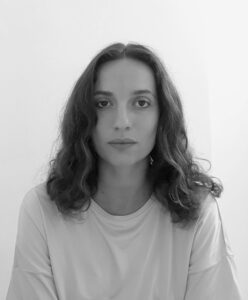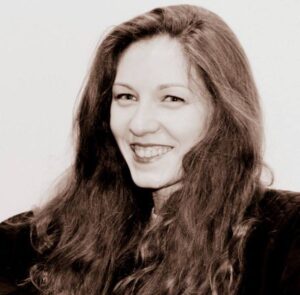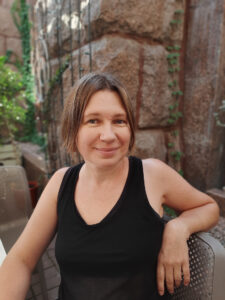Jelena Micić
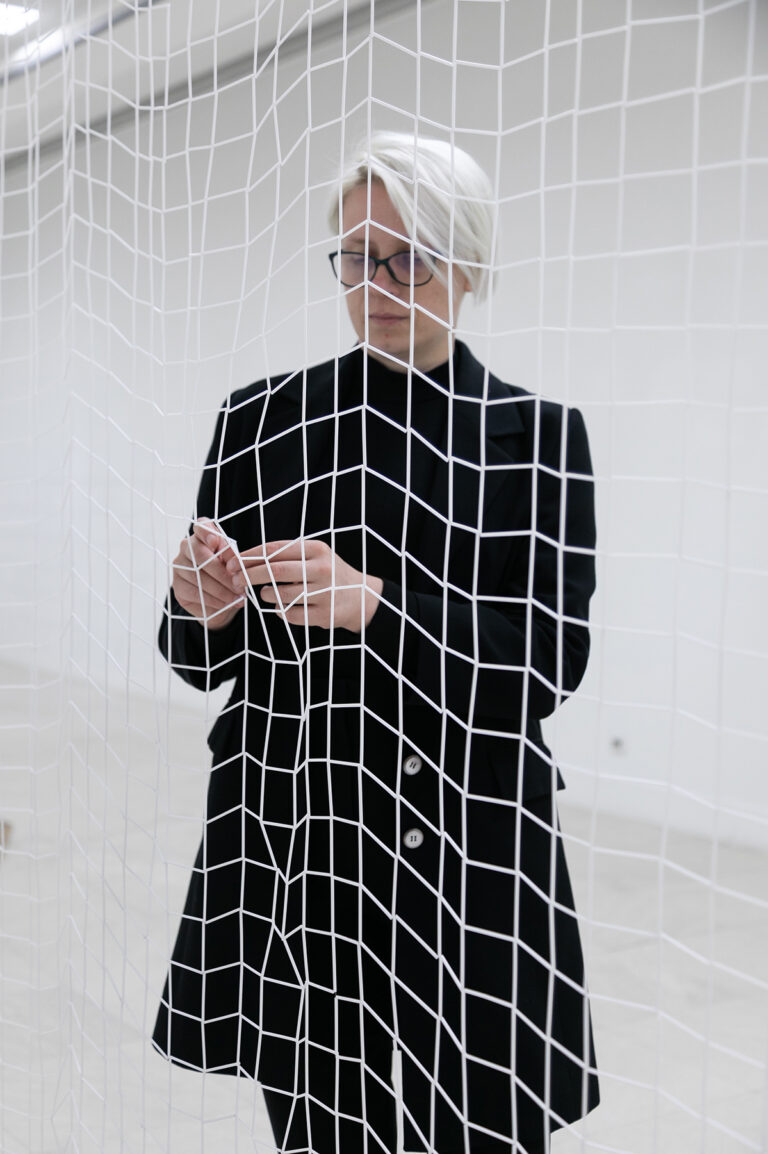
- abstraction
- artist in society
- critical art
- eco-feminism
- ecology
- everyday
- female
- female body
- feminism
- household
- housework
- labor
- material experience
- painting
- painting extended to spatial contexts
- performative art
- site-specific
- social criticism
- social problems
- structure in painting
- traditional female roles
– born in Knjaževac, Serbia, in 1986, and is currently living in Vienna, Austria. She received a master’s degree at the Department of Textual Sculpture at the Academy of Fine Arts in Vienna (2020), has a master’s degree in philosophy, and a graduate degree in the philology of Scandinavian languages and literature (2010) from the University of Belgrade. In addition to her individual artistic practice which includes painting and spatial installations, she is a member of the informal group “UMETNIK*” and the women’s collective “I KNOW I CARE”.
Portrait of Jelena Micić, 2021, photo: Ivan Zupanc, courtesy of the artist.
The (un)civil (dis)obedience of an (un)grateful immigrant
In my artistic practice12, I focus on the social and political aspects of colour and systems of colour, and a large part of my method involves the act of collecting, that is from personal, usually work-related experiences, to specific materials such as single-use plastic. The basic processes of my artistic expression are ready-made and in situ, although there are other roles in my activities such as curating and writing. I have now been given the opportunity to express my cultural and political opinions via the position of art director of the 11th art and activism festival “WIENWOCHE” in Vienna, the first art director coming from a “third country” and without permanent residence in Austria.
My everyday life consists of investing in additional (in)visible work, since as a (non-)citizen I am entitled to only take on certain auxiliary roles in the reproduction of the system, and am exclusively outside it. I deal with limitations every day whose effect is the disintegration of my established professional and personal roles. I experienced for the first time in my life discrimination based on my nationality and economic background on arriving in Austria to study painting at the Vienna Academy. At the beginning of my career I resisted the idea of expressing in my work these experiences and this discomfort because I always had a somewhat naive idea that I could become an abstract painter without class, gender or nationality.
I began the series of performances titled “PUTZMALEREI”3 in 2016 when I was a student working as a cleaning woman in Vienna; while the series “Maintaining the Pictures”4 explores the parallel nature of gestures in my work, as a cleaning woman and an artist, the installation “Theory of Colour“567 [FARBENLEHRE] refers to the specific rules for using colour in professional cleaning8, which I then develop further in “Twisting by the Pool”910 where I directly confront visitors with a cleaning liquid which causes allergic reactions in the women who work in the maintenance of hygiene.
The “Colour Catcher”111213 is a pigment archive from my everyday surroundings, mostly from my home, and it is based on locating the pigments of various soil types from my neighbourhood.1415 I collect the materials for my spatial installations during work, or rather from their consumption. Packaging nets for fruits and vegetables indicate the type of product they contain, so my work “Colour-battlefields”161718 reflects my economic situation simply by the fact that most of the nets are made of plastic19. I collected the 25kg potato bag nets by cleaning a well-known restaurant/tourist attraction in Vienna2021, whilst for current and future artworks I collect the last remaining plastic ear swabs which are now illegal in the EU22232425.
From my own experience, I can confirm that the system forces one into illegal work due to limited access to the job market, that it encourages only the inclusion of desired social categories and requires permanent residence as a basis for integration and potential equality. I believe that identity politics additionally supports differentiation between people, and neoliberalism encourages and strengthens a state of selfishness and non-solidarity. Social pressure can be articulated through self-organised and united political action but the current political practices, to the contrary, contribute to self-censorship and self-exoticisation. Profiting from practices based on the culture of remembering Yugoslavia is a temptation, and it is a sure road to instant success and a short-lived career. I don’t like the essentialisation of Central-South-Eastern European art which we all partly consent to. On the contrary, I believe it is possible to construct a narrative of non-self-discriminating egalitarianism.
The text is written in collaboration with Dejan Vasić (2022).
1See: umetniksazvezdi.com/home/content/15/o-nama.2See: instagram.com/iknowicare.vienna/.
3Image: Jelena Micić “PUTZMALEREI“, acrylic on canvas (mop), 2016, photo: Jelena Micić, courtesy of the artist. The title refers to two concepts: putzen–to clean, Malerei– painting.
4Image: Jelena Micić “Maintaining the Pictures“, performance, 2016, photo: Žarko Aleksić, courtesy of the artist.
5Image: Jelena Micić “Theory of Colour: Red/Yellow“, spatial installation, 2018, photo: Wiener Städtische Versicherungsverein, courtesy of the artist.
6Image: Jelena Micić “Theory of Colour: Green“, spatial installation of the former laundry Waschhalle Wienerberg, 2019, photo: Jelena Micić, courtesy of the artist.
7Image: Jelena Micić “Theory of Colour: Blue“, spatial installation, 2020, photo: Jelena Micić, courtesy of the artist.
8The four-colour system is based on the fact that the red cloth, i.e. the cleaning solution, is always and exclusively used for the toilet bowl and tiles, yellow for the sink, green for the kitchen surfaces, and blue for office furniture and work space.
9Image: Jelena Micić “Twisting by the Pool“, spatial installation, 2021, photo: Jelena Micić, courtesy of the artist.
10Image: Jelena Micić “Twisting by the Pool“, spatial installation, 2021, photo: Jelena Micić, courtesy of the artist.
11Image: Jelena Micić “Colour Catcher“, washing machine papers, household pigments 2019-2021, photo: Johannes Puch, courtesy of the artist.
12Image: Jelena Micić “Colour Catcher“, washing machine papers, household pigments 2019-2021, photo: Johannes Puch, courtesy of the artist.
13Image: Jelena Micić “Colour Catcher“, washing machine papers, household pigments 2019-2021, photo: Johannes Puch, courtesy of the artist.
14Image: Jelena Micić “Palette of my Homeland“, soil on canvas, 2017, photo: Jelena Micić, courtesy of the artist.
15The paper contains soil types with local names: Beljuga, Lekun, Crvenica, Plodnjača, courtesy of the artist.
16Image: Jelena Micić “Battlefields/Color Fields“, spatial installation, 2016-2021, photo: Jelena Micić, courtesy of the artist.
17Image: Jelena Micić “Battlefields/Colour Fields“, spatial installation, 2016-2021, photo: Jelena Micić, courtesy of the artist.
18Image: Jelena Micić “Battlefields/Colour Fields“, spatial installation, 2016-2021, photo: Jelena Micić, courtesy of the artist.
19Plastic nets are used for imported, cheap products, while cotton nets are used for packaging organic products. The colour of the nets usually corresponds to the colour of the product, so lemons are always packed in yellow, and courgettes in green nets.
20Image: Jelena Micić “No-yellow“, spatial installation, 2018, photo: Jelena Micić, courtesy of the artist.
21Image: Jelena Micić “No-yellow“, spatial installation, 2018, photo: Jelena Micić, courtesy of the artist.
22Image: Jelena Micić “Untitled“, spatial installation, 2019-2022, photo: Jelena Micić, courtesy of the artist.
23Image: Jelena Micić “Untitled“, spatial installation, 2019-2022, photo: Jelena Micić, courtesy of the artist.
24Image: Jelena Micić “Untitled“, spatial installation, 2019, photo: Jelena Micić, courtesy of the artist.
25Image: Jelena Micić “Untitled“, spatial installation, 2019, photo: Jelena Micić, courtesy of the artist.
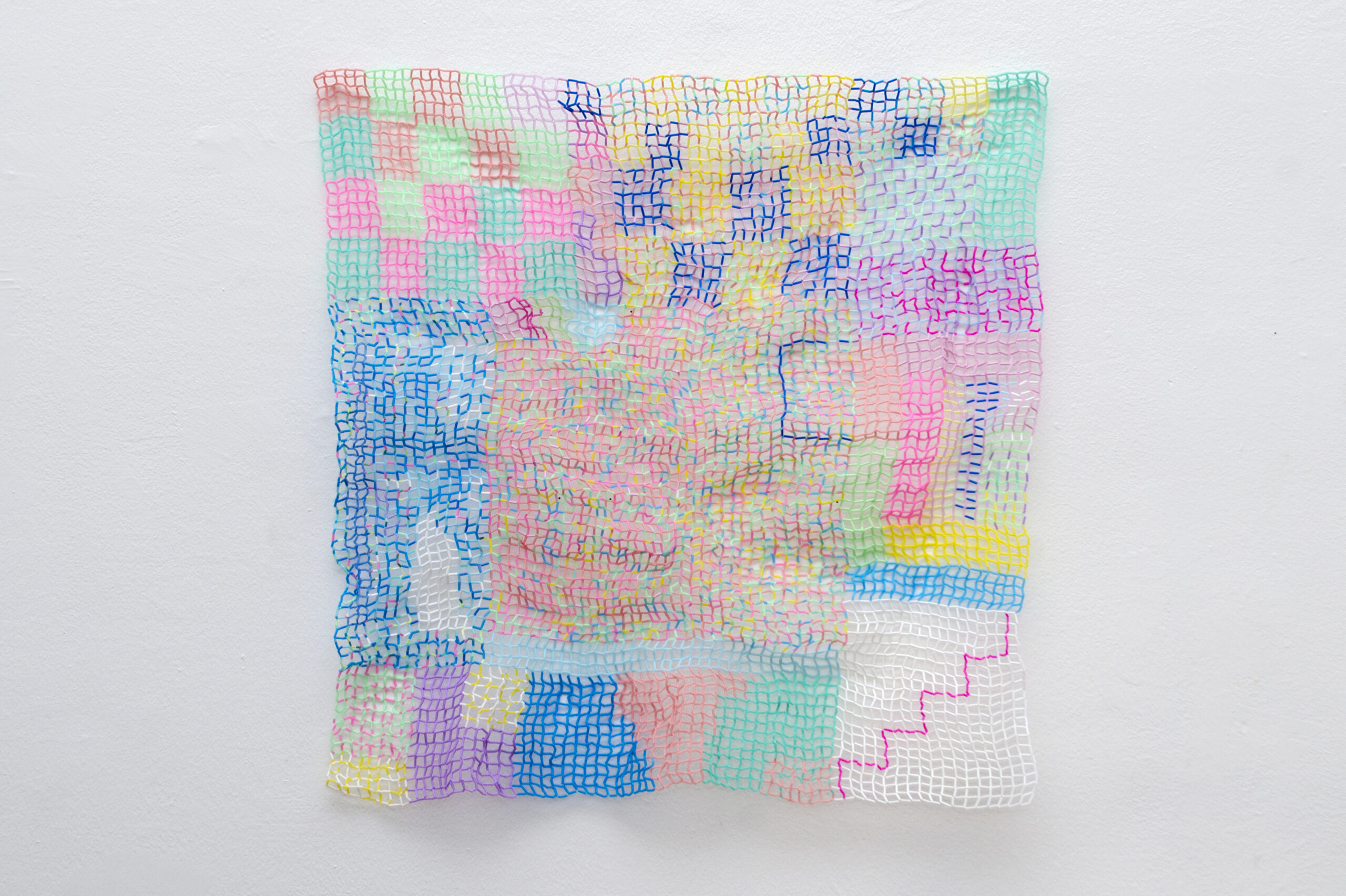
– rođena je 1986. godine u Knjaževcu u Srbiji, i trenutno živi i radi u Beču u Austriji. Magistrirala je na odseku za Tekstualnu skulpturu Akademiji likovnih umetnosti u Beču (2020), master je Filozofije, i diplomirani je filolog Skandinavskih jezika i književnosti (2010) na Univerzitetu u Beogradu. Pored individualne umetničke prakse u kojoj se bavi slikarstvom i prostornim instalacijama, članica je neformalne grupe „UMETNIK*“ i ženskog kolektiva „I KNOW I CARE“.
Portret Jelene Micić, 2021., foto: Ivan Zupanc, ljubaznošću umetnice.
(Ne)građanska (ne)poslušnost (ne)zahvalne imigrantkinje
U svojoj umetničkoj praksi12 bavim se društveno-političkim aspektima boje i bojnih sistema, a veliki udeo u metodu mog rada ima sakupljačka delatnost koja seže od ličnih, obično radnih iskustava, do targetiranih materijala, kao što je plastika za jednokratnu upotrebu. Redimejd i in situ su osnovni postupci mog umetničkog izražavanja, mada se moje delovanje često proteže i na druge uloge, kao što je kuriranje ili pisanje. Trenutno imam priliku da svoje kulturno-političke stavove izrazim kroz poziciju umetničke direktorke XI izdanja festivala za umetnost i aktivizam „WIENWOCHE“ u Beču, prve koja dolazi iz „Trećih zemalja“ i nema stalni boravak u Austriji.
Moj svakodnevni život se sastoji u investiranju dodatnog (ne)vidljivog rada, budući da mi je kao (ne)građanki namenjen samo određen okvir pomoćnih uloga u reprodukciji sistema, i to isključivo izvan njega. Svakodnevno se suočavam sa ograničenjima koja utiču na rastakanje moje profesionalne i životne uloge. Dolaskom u Austriju zbog studija slikarstva na Bečkoj Akademiji, po prvi put sam bila diskriminisana po nacionalnoj i ekonomskoj osnovi. Na samom početku karijere sam se odupirala ideji da svoja iskustva i nelagode tematizujem kroz radove, jer sam oduvek imala pomalo naivnu ideju da bih mogla postati apstraktna slikarka, bez klasne, rodne ili nacionalne odrednice.
Seriju performativnih radova „PUTZMALEREI“3 započela sam 2016. godine, kao studentkinja koja radi kao čistačica u Beču, dok serija „Održavanje slika“4 [Maintaining the Pictures] tematizuje paralelu između gestova u mom radu, kao čistačice i umetnice. Instalacija „Teorija boja“567 [FARBENLEHRE] referiše na postojanje specifičnih pravila o upotrebi boje u profesionalnom čišćenju,8 koje zatim razrađujem u radu „Đuskanje kraj bazena“910 (Twisting by the Pool) time što posetioce direktno suočavam sa sredstvom za čišenje koje izaziva alergijske reakcije kod radnica koje rade na održavanju higijene.
„Hvatač boja“ (Color catcher)111213 je arhiva uzoraka pigmenta iz mog svakodnevnog okruženja, uglavnom domaćinstva, a naslanja se na lociranje pigmenata tipova zemlje iz moga kraja1416. Materijale kao osnovne gradivne elemente prostornih instalacija sakupljam tokom rada ili pak potrošnje. Mrežice za pakovanje voća i povrća upućuju na tip i vrstu proizvoda koje sadrže, pa tako rad „Bojna polja“151718odslikava i moju ekonomsku situaciju, samom činjenicom da je najveći broj mrežica od plastike19. Mrežice od 25kg krompira sakupila sam čisteći jedan od poznatih turističkih restorana-atrakcija u Beču,2021 a poslednje primerke štapića za uši sa plastičnom drškom, koji su zabranjeni u Evropskoj uniji, skladištim za aktuelne i predstojeće serije radova22232425.
Iz sopstvenog iskustva mogu da potvrdim da sistem forsira rad na crno u uslovima ograničenog pristupa tržištu rada, podstiče inkluziju željenih kategorija, i podrazumeva stalni boravak kao osnovu integracije i eventualne jednakosti. Smatram da su identitetske politike dodatno podržale diferencijaciju između ljudi, a neoliberalizam podstakao i osnažio stanje samoživosti i nesolidarnosti. Verujem da društveni pritisak može da bude artikulisan kroz samoorganizovanu i ujedinjenu političku akciju, ali da trenutno aktuelne umetničke prakse, nasuprot tome, doprinose autocenzuri i samoegzotizaciji. Ubiranje profita kroz prakse zasnovane na kulturi sećanja na Jugoslaviju jeste primamljivo i predstavlja siguran put za instant uspeh i kratkotrajnu karijeru. Ne dopada mi se esencijalizacija na Centralno-jugo-istočnoevropsku umetnost na koju svi mi delimično pristajemo. Nasuprot, verujem da je moguće izgraditi narativ ne-samodiskriminišućeg egalitarizma.
Tekst je napisan u saradnji sa Dejanom Vasićem (2022.).
1Link: umetniksazvezdi.com/home/content/15/o-nama.2Link: instagram.com/iknowicare.vienna/.
3Ilustracija: Jelena Micić „PUTZMALEREI“, akril na platnu (mop), 2016., foto: Jelena Micić, ljubaznošću umetnice.
4Ilustracija: Jelena Micić „Održavanje slika“, performans, 2016., foto: Žarko Aleksić, ljubaznošću umetnice.
5Ilustracija: Jelena Micić „Teorija boja: Crvena/žuta“, instalacija u prostoru, 2018., foto: Wiener Städtische Versicherungsverein, ljubaznošću umetnice.
6Ilustracija: Jelena Micić „Teorija boja: Zelena“, instalacija u prostoru bivše perionice Waschhalle Wienerberg, 2019., foto: Jelena Micić, ljubaznošću umetnice.
7Ilustracija: Jelena Micić „Teorija boja: Plava“, instalacija u prostoru, 2020., foto: Jelena Micić, ljubaznošću umetnice.
8Četvorobojni-sistem se zasniva na činjenici da se crvena krpa, odnosno sredstvo za čišćenje, uvek i isključivo koristi za WC-šolju i pločice, žuta za lavabo, zelena za kuhinjske površine, a plava za kancelarijski nameštaj i radni prostor, ljubaznošću umetnice.
9Ilustracija: Jelena Micić „Đuskanje kraj bazena“, instalacija u prostoru, 2021., foto: Jelena Micić, ljubaznošću umetnice.
10Ilustracija: Jelena Micić „Đuskanje kraj bazena“, instalacija u prostoru, 2021., foto: Jelena Micić, ljubaznošću umetnice.
11Ilustracija: Jelena Micić „Hvatač boja“, papiri za mašinsko pranje, kućni pigmenti, 2019-2021., foto: Johanes Puk, ljubaznošću umetnice.
12Ilustracija: Jelena Micić „Hvatač boja“, papiri za mašinsko pranje, kućni pigmenti, 2019-2021., foto: Johanes Puk, ljubaznošću umetnice.
13Ilustracija: Jelena Micić „Hvatač boja“, papiri za mašinsko pranje, kućni pigmenti, 2019-2021., foto: Johanes Puk, ljubaznošću umetnice.
14Ilustracija: Jelena Micić „Paleta mog kraja“, zemlja na platnu, 2017., foto: Jelena Micić, ljubaznošću umetnice.
15Rad sadrži tipove zemlje sa lokalnim nazivima: Beljuga, Lekun, Crvenica, Plodnjača, ljubaznošću umetnice.
16Ilustracija: Jelena Micić „Bojna polja“, instalacija u prostoru, 2016-2021., foto: Jelena Micić, ljubaznošću umetnice.
17Ilustracija: Jelena Micić „Bojna polja“, instalacija u prostoru, 2016-2021., foto: Jelena Micić, ljubaznošću umetnice.
18Ilustracija: Jelena Micić „Bojna polja“, instalacija u prostoru, 2016-2021., foto: Jelena Micić, ljubaznošću umetnice.
19Plastične mrežice se koriste za uvezene, jeftine proizvode, dok se pamučne mrežice koriste za pakovanje organskih proizvoda. Boja mrežice u najvećem broju slučajeva korenspondira sa bojom proizvoda, pa je tako limun pakovan uvek u žutu, a tikvice u zelenu mrežicu.
20Ilustracija: Jelena Micić „No-yellow“, instalacija u prostoru, 2018., foto: Jelena Micić, ljubaznošću umetnice.
21Ilustracija: Jelena Micić „No-yellow“, instalacija u prostoru, 2018., foto: Jelena Micić, ljubaznošću umetnice.
22Ilustracija: Jelena Micić „Bez naziva“ , instalacija u prostoru, 2019-2022., foto: Jelena Micić, ljubaznošću umetnice.
23Ilustracija: Jelena Micić „Bez naziva“, instalacija u prostoru, 2019-2022., foto: Jelena Micić, ljubaznošću umetnice.
24Ilustracija: Jelena Micić „Bez naziva“ , instalacija u prostoru, 2019., foto: Jelena Micić, ljubaznošću umetnice.
25Ilustracija: Jelena Micić „Bez naziva“ , instalacija u prostoru, 2019., foto: Jelena Micić, ljubaznošću umetnice.
- abstraction
- artist in society
- critical art
- eco-feminism
- ecology
- everyday
- female
- female body
- feminism
- household
- housework
- labor
- material experience
- painting
- painting extended to spatial contexts
- performative art
- site-specific
- social criticism
- social problems
- structure in painting
- traditional female roles
